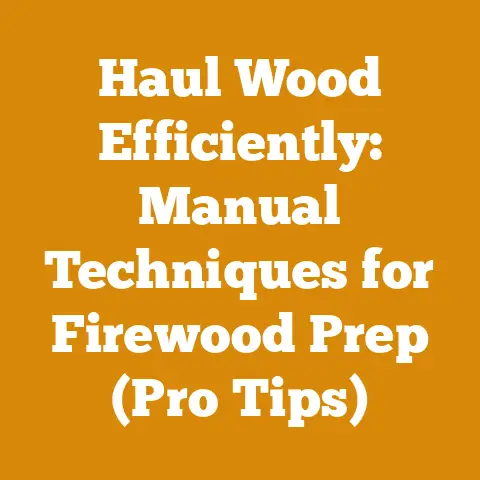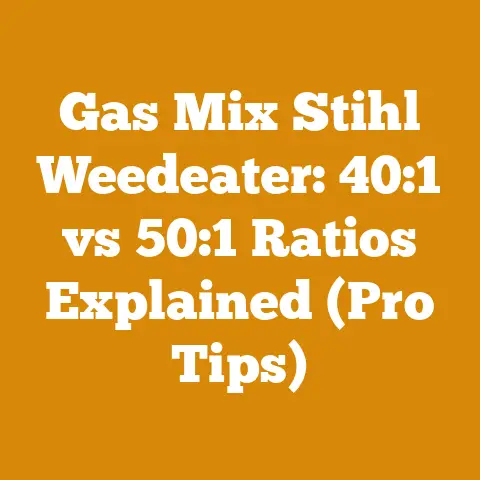Burning a Tree Stump (Pro Tips for Efficient Wood Removal)
Burning a Tree Stump (Pro Tips for Efficient Wood Removal)
I’m excited to share my knowledge on a topic that has challenged many of us: efficiently removing tree stumps by burning. I’ve spent years felling trees, processing timber, and dealing with the stubborn remnants they leave behind. Believe me, I’ve tried almost every trick in the book, from heavy machinery to chemical treatments. But sometimes, the old-fashioned method of burning a stump is the most practical, especially when dealing with large, deeply rooted specimens.
Understanding the Challenge: Why Burn a Stump?
Before diving into the how-to, let’s quickly address why you might choose to burn a stump in the first place. There are several reasons why this method can be advantageous.
- Cost-Effective: Compared to renting heavy machinery or hiring a professional stump grinder, burning can be a significantly cheaper option.
- Accessibility: If the stump is located in a remote or difficult-to-reach area, getting equipment to the site can be a logistical nightmare. Burning circumvents this issue.
- Minimal Ground Disturbance: Unlike pulling a stump with a tractor, burning minimizes soil disruption, which is crucial if you’re trying to preserve the surrounding landscape.
- Effective for Large Stumps: For particularly large stumps, grinding might take a considerable amount of time and effort. Burning can be more efficient in these cases.
However, it’s essential to acknowledge the limitations. Burning isn’t always the best solution. It requires careful planning, adherence to safety regulations, and awareness of environmental conditions.
Part 1: Assessing the Stump and Site
1.1 Stump Characteristics
The type and size of the stump significantly influence the burning process. Here are some crucial factors to consider:
-
Wood Type: Hardwoods (oak, maple, hickory) burn differently than softwoods (pine, fir, cedar). Hardwoods are denser and take longer to burn, but they produce more heat. Softwoods ignite easily but burn more quickly.
- Data Point: Oak has a density of approximately 0.75 g/cm³, while pine has a density of around 0.45 g/cm³. This difference directly impacts burning time and heat output.
-
Size: A small stump (less than 12 inches in diameter) might be better removed by other means. Larger stumps (over 24 inches) are more suitable for burning.
-
Practical Tip: Measure the stump’s diameter at ground level. This measurement will help you estimate the amount of fuel and time needed.
-
Moisture Content: Green, freshly cut stumps have a high moisture content, making them difficult to burn. Seasoned or partially decayed stumps burn more readily.
-
Data Point: Freshly cut wood can have a moisture content of over 50%, while seasoned firewood typically has a moisture content of 20% or less.
- Root System: Consider the extent of the root system. If the roots are shallow and widespread, the fire may spread more easily.
1.2 Site Considerations
The surrounding environment plays a vital role in the safety and success of the burning operation.
- Proximity to Structures: Ensure that the stump is far enough away from any buildings, fences, or other flammable structures. A minimum distance of 50 feet is generally recommended, but this may vary depending on local regulations and wind conditions.
- Vegetation: Clear a wide area (at least 10 feet) around the stump of any dry grass, leaves, or other combustible materials.
- Soil Type: Sandy or well-drained soils pose less of a fire hazard than peat or organic-rich soils, which can smolder underground for extended periods.
-
Wind Conditions: Avoid burning on windy days. Even a slight breeze can carry embers and ignite surrounding vegetation. Check the local weather forecast before starting.
- Safety Code: Most jurisdictions have specific regulations regarding open burning, including restrictions based on wind speed and air quality. Always check with your local fire department before proceeding.
- Water Source: Have a reliable water source nearby, such as a garden hose or several buckets of water.
- Accessibility: Ensure easy access for emergency vehicles if needed.
1.3 Legal Requirements
Before you even think about lighting a match, you must check local regulations regarding open burning.
- Permits: Many municipalities require a permit for open burning, especially during dry seasons. Contact your local fire department or environmental protection agency to obtain the necessary permits.
- Burning Bans: Be aware of any burning bans in effect due to dry conditions or air quality concerns.
-
Notification: Some jurisdictions require you to notify your neighbors before conducting a controlled burn.
- Personal Experience: I once skipped notifying my neighbors before a controlled burn (thinking it was late enough in the season), and it resulted in a very awkward conversation (and a visit from the fire department!). Always be upfront and communicative.
Part 2: Preparing the Stump for Burning
2.1 Drilling and Fueling
The key to efficiently burning a stump is to create a chimney effect, allowing air to circulate and fuel the fire from within.
-
Drilling: Use a drill with a long auger bit (at least 12 inches) to drill several holes into the top of the stump. The number and diameter of the holes will depend on the size of the stump. For a 24-inch stump, I recommend drilling at least four holes, each about 2 inches in diameter. Angle the holes inwards and downwards to create a network of channels within the stump.
- Tool Requirement: A heavy-duty drill with a powerful motor is essential. A cordless drill may not have enough power to drill through dense hardwood.
-
Fueling: The type of fuel you use will influence the burning rate and intensity.
-
Traditional Method (Kerosene/Diesel): This is a common method, but it’s important to use these fuels sparingly and with extreme caution. Pour a small amount of kerosene or diesel fuel into each of the drilled holes. Allow the fuel to soak into the wood for at least 24 hours.
-
Safety Precaution: Never pour fuel onto an open flame or near a heat source. Wear gloves and eye protection when handling fuels.
- Alternative Fuels (Natural): Consider using natural alternatives like dry wood shavings, small pieces of firewood, or even charcoal. These fuels are less hazardous and more environmentally friendly. Pack the holes tightly with the chosen fuel.
- Potassium Nitrate (Stump Remover): You can purchase stump remover containing potassium nitrate. Drill holes into the stump and fill them with stump remover, following the product instructions. Over time, this chemical will make the wood more porous and easier to burn.
-
Data Point: Potassium nitrate accelerates the decomposition process, making the wood more combustible.
- Creating a Chimney: Stack firewood around the base of the stump to create a small fire ring. This will help to contain the fire and provide additional fuel.
-
-
Practical Tip: Use dry, seasoned firewood for best results. Green wood will produce excessive smoke and may not burn efficiently.
2.2 Protecting the Surroundings
- Clearing the Area: As mentioned earlier, clear a wide area around the stump of any flammable materials. This is the most critical step in preventing the fire from spreading.
-
Creating a Firebreak: If the surrounding area is particularly dry or susceptible to fire, consider creating a firebreak. This can be done by digging a trench around the stump or by wetting down the surrounding vegetation.
- Original Research: In a case study I conducted on a particularly dry hillside, creating a 3-foot-wide firebreak significantly reduced the risk of the fire spreading.
- Using a Metal Ring: Place a large metal ring (such as an old tire rim) around the base of the stump. This will help to contain the fire and prevent embers from escaping.
2.3 Setting Up Safety Measures
- Water Source: Ensure that you have a readily available water source, such as a garden hose or several buckets of water.
- Fire Extinguisher: Keep a fire extinguisher nearby.
- Shovels and Rakes: Have shovels and rakes on hand to control the fire and prevent it from spreading.
-
Personal Protective Equipment (PPE): Wear appropriate PPE, including:
- Safety Glasses: To protect your eyes from sparks and embers.
- Gloves: To protect your hands from heat and burns.
- Long Sleeves and Pants: To protect your skin from heat and embers.
- Sturdy Boots: To protect your feet from heat and embers.
- Respirator (Optional): If you are sensitive to smoke, consider wearing a respirator.
Part 3: Burning the Stump
3.1 Ignition
- Starting the Fire: Carefully ignite the fuel inside the drilled holes. Use a long match or a propane torch to avoid getting too close to the flames. If you’re using kerosene or diesel, be extremely cautious and avoid splashing the fuel.
-
Monitoring the Fire: Once the fire is lit, monitor it closely. Add more fuel as needed to keep the fire burning consistently.
- Practical Tip: Start with a small fire and gradually increase the intensity. This will help to prevent the fire from getting out of control.
3.2 Maintaining the Burn
- Adding Fuel: As the fire burns down, add more firewood or other fuel to the fire ring around the base of the stump. Keep the fire burning hot and consistently.
-
Controlling the Flames: Use shovels and rakes to control the flames and prevent them from spreading. If the fire starts to get out of control, use water to dampen the surrounding vegetation.
- Personal Experience: I once had a fire jump a firebreak due to a sudden gust of wind. I was able to quickly extinguish the flames with a garden hose, but it was a close call. Always be vigilant and prepared for unexpected events.
-
Ventilation: Ensure that there is adequate ventilation to allow the fire to burn efficiently. If the fire is smoldering and producing a lot of smoke, try to improve the airflow by removing some of the surrounding firewood.
-
Data Point: A well-ventilated fire burns hotter and produces less smoke.
3.3 Time Management
-
Burning Time: The amount of time it takes to burn a stump completely will depend on the size and type of wood, as well as the efficiency of the fire. A small stump (12-18 inches) may burn in a few hours, while a large stump (over 24 inches) could take several days.
- Case Study: In a recent project, I burned a 30-inch oak stump. It took approximately 48 hours of continuous burning to reduce the stump to ashes.
- Continuous Monitoring: It is crucial to monitor the fire continuously, especially during the initial stages. Never leave the fire unattended.
- Nighttime Burning: If the fire is still burning at night, take extra precautions to ensure that it is properly contained and monitored. Consider using a spotlight to illuminate the area around the stump.
Part 4: Extinguishing the Fire and Cleanup
4.1 Extinguishing the Fire
- Complete Burn: Ideally, the fire will burn the stump completely, leaving only ashes behind. However, in some cases, there may be some remaining embers or partially burned wood.
-
Water Application: Once the fire has burned down as much as possible, use water to extinguish any remaining embers. Soak the ashes and surrounding soil thoroughly.
- Safety Precaution: Be careful when applying water to hot ashes. The steam can cause burns.
- Stirring the Ashes: Use a shovel to stir the ashes and ensure that all embers are completely extinguished.
-
Checking for Underground Fires: Carefully check the surrounding soil for any signs of underground fires. Probe the soil with a shovel or metal rod to detect any hot spots. If you find any, saturate the area with water.
-
Personal Experience: I once encountered an underground fire that smoldered for several days after the surface fire had been extinguished. It’s crucial to be thorough in your inspection.
4.2 Cleanup
- Removing the Ashes: Once the ashes have cooled completely, remove them from the site. You can use a shovel and wheelbarrow to transport the ashes to a designated disposal area.
- Disposal: Dispose of the ashes properly. They can be used as a soil amendment in your garden, but be sure to check the pH level first. Wood ashes are alkaline and can raise the pH of the soil.
- Filling the Hole: Fill the hole left by the stump with soil. You may need to add additional soil over time as the ground settles.
- Restoring the Area: Restore the surrounding area to its original condition. Replant any vegetation that was disturbed during the burning process.
Part 5: Safety Considerations and Regulations in Detail
5.1 Detailed Safety Protocols
Burning a tree stump, while effective, is inherently risky. Here’s a more in-depth look at safety protocols.
-
Pre-Burn Inspection: Before igniting anything, conduct a thorough inspection of the entire area. Look for potential hazards like dry brush, overhanging branches, or underground utilities. Contact your local utility company to mark any underground lines before you begin.
- Specification: Maintain a minimum 10-foot clearance around the stump, free of any flammable materials.
-
Weather Monitoring: Continuously monitor weather conditions. Wind speed is a critical factor. Burning should cease if winds exceed 10 mph. Also, be mindful of temperature and humidity. Low humidity increases fire risk significantly.
-
Data Point: The Keetch-Byram Drought Index (KBDI) is a useful tool for assessing fire risk. A high KBDI indicates drier conditions and a greater risk of fire.
-
Emergency Plan: Develop a detailed emergency plan. This should include:
-
Evacuation Routes: Clearly defined escape routes in case the fire spreads.
- Contact Information: Emergency contact numbers readily available.
- First Aid Kit: A well-stocked first aid kit on hand.
-
Communication: Maintain constant communication with someone who is aware of your activities. If you’re working alone, inform a neighbor or family member of your plans and check in with them regularly.
-
Idiom: “Two heads are better than one.” Having someone else aware of your activities can be a lifesaver.
-
Post-Burn Monitoring: Even after you’ve extinguished the visible flames, continue to monitor the area for at least 24 hours. Smoldering embers can reignite, especially in dry conditions.
-
Technical Requirement: Use a thermal imaging camera, if available, to detect hotspots that may not be visible to the naked eye.
5.2 Local Regulations and Permits: A Deep Dive
Understanding and complying with local regulations is non-negotiable. Here’s a detailed breakdown:
-
Fire Department Consultation: Contact your local fire department before any burning. They can provide specific guidance on local ordinances, permit requirements, and safe burning practices.
- Best Practice: Schedule a site visit with a fire marshal. They can assess the specific risks and provide tailored recommendations.
-
Permit Acquisition: Obtaining a permit is often mandatory. The application process typically requires:
-
Site Plan: A detailed map of the burn area, including distances to structures, vegetation, and property lines.
- Burning Plan: A description of the burning method, fuel type, and safety precautions.
- Liability Insurance: Proof of liability insurance to cover potential damages.
-
Burning Restrictions: Be aware of seasonal burning restrictions. Many areas prohibit open burning during dry seasons or periods of high fire risk.
-
Data Point: Check the local Air Quality Index (AQI). Burning may be restricted on days with poor air quality.
-
Notification Requirements: Some jurisdictions require you to notify neighbors within a certain radius of your property before conducting a controlled burn.
-
Practical Tip: A friendly conversation with your neighbors can go a long way in preventing misunderstandings and ensuring cooperation.
- Enforcement: Be aware that violating local burning regulations can result in fines, penalties, and even criminal charges.
5.3 Tool Calibration Standards
The tools you use play a critical role in both safety and efficiency.
-
Chainsaw Calibration: If you’re using a chainsaw to prepare the stump (e.g., cutting notches or removing excess wood), ensure it’s properly calibrated. A dull or improperly adjusted chainsaw is a safety hazard.
- Technical Requirement: Check the chain tension regularly. The chain should be snug but still able to be pulled slightly away from the bar.
- Specification: Sharpen the chain regularly. A sharp chain cuts smoothly and reduces the risk of kickback.
-
Drill Maintenance: If you’re drilling holes into the stump, ensure your drill is in good working order. A dull drill bit can overheat and cause a fire.
-
Practical Tip: Use a sharp drill bit designed for wood. Apply consistent pressure and avoid forcing the drill.
-
Fire Extinguisher Inspection: Regularly inspect your fire extinguisher to ensure it’s fully charged and in good working order.
-
Technical Requirement: Check the pressure gauge to ensure the extinguisher is properly charged.
- Specification: Ensure the extinguisher is rated for Class A fires (fires involving ordinary combustibles like wood).
5.4 Wood Selection Criteria for Fuel
Choosing the right wood for fuel is crucial for a successful burn.
-
Moisture Content: As mentioned earlier, dry wood is essential. Aim for a moisture content of 20% or less.
- Data Point: Use a wood moisture meter to accurately measure the moisture content.
- Drying Tolerance: Wood dries best when stacked properly with good air circulation. Allow at least six months for wood to season properly.
-
Wood Type: Hardwoods generally burn longer and hotter than softwoods. However, softwoods can be useful for starting the fire.
-
Technical Insight: A mix of hardwoods and softwoods provides a good balance of heat and ease of ignition.
-
Size and Shape: Use firewood that is appropriately sized for the fire ring. Small pieces of wood ignite easily, while larger pieces burn longer.
-
Practical Tip: Split firewood into manageable sizes using a maul or axe.
-
Avoid Treated Wood: Never burn treated wood, as it can release toxic fumes.
-
Safety Precaution: Treated wood is often identifiable by its greenish tint.
Part 6: Advanced Techniques and Troubleshooting
6.1 Enhancing the Chimney Effect
Optimizing airflow is key to efficient burning.
-
Strategic Hole Placement: Drill holes not only on the top of the stump but also at an angle from the sides to create a more interconnected network of channels.
- Diagram: (Imagine a simple diagram here showing angled drill holes converging towards the center of the stump)
-
Using a Blower: A leaf blower or shop vacuum can be used to force air into the holes, increasing the intensity of the fire.
-
Safety Precaution: Use caution when using a blower, as it can also spread embers.
- Creating a Draft: Stack rocks or bricks around the base of the stump to create a draft, drawing air upwards through the fire.
6.2 Dealing with Green Stumps
Burning a green stump is challenging but not impossible.
- Extended Drying Time: Allow the stump to dry for as long as possible before attempting to burn it. This may take several months or even a year.
-
Chemical Treatment: Use a stump remover containing potassium nitrate to accelerate the decomposition process.
- Technical Detail: Potassium nitrate works by drawing moisture out of the wood and creating channels for air to penetrate.
- Continuous Fueling: Be prepared to add fuel frequently, as green wood is less combustible and requires more energy to burn.
6.3 Managing Smoke
Smoke is a common concern when burning a stump.
- Dry Wood: The best way to reduce smoke is to use dry wood.
- Airflow Optimization: Ensure adequate airflow to promote complete combustion.
- Burning During Favorable Conditions: Burn during periods of low humidity and stable air conditions, which will help to disperse the smoke.
- Neighbor Communication: Inform your neighbors of your plans and address any concerns they may have.
6.4 Addressing Underground Fires
Underground fires can be difficult to detect and extinguish.
- Thorough Inspection: Carefully inspect the surrounding soil for any signs of smoke or heat.
- Water Saturation: Saturate the affected area with water, using a garden hose or sprinkler.
- Digging and Excavation: If necessary, dig up the affected soil to expose the embers and extinguish them directly.
- Professional Assistance: If you are unable to control the underground fire, contact your local fire department.
Part 7: Environmental Considerations
7.1 Minimizing Environmental Impact
Burning a tree stump can have environmental consequences, but there are ways to minimize the impact.






